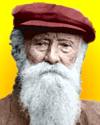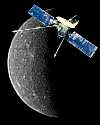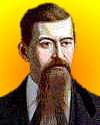 | TODAY IN SCIENCE HISTORY NEWSLETTER - 29 MARCH |
| Feature for Today |
 On 29 Mar 1921, John Burroughs died. As a naturalist and author, his writings were after the manner of Henry David Thoreau. You can enjoy his reflections on nature with this short sample, an excerpt from Under the Apple-Trees (1916), the chapter called "The Friendly Rocks." On 29 Mar 1921, John Burroughs died. As a naturalist and author, his writings were after the manner of Henry David Thoreau. You can enjoy his reflections on nature with this short sample, an excerpt from Under the Apple-Trees (1916), the chapter called "The Friendly Rocks."It's a quick read, but let it sink in, and on the next on the next walk you take in the country, the simple stones and rocky outcrops you see will pleasantly remind you of Burroughs' words. |
| Book of the Day | |
| |
| Quotations for Today | |
 | "Advocacy of leaf protein as a human food is based on the undisputed fact that forage crops (such as lucerne) give a greater yield of protein than other types of crops. Even with connventional food crops there is more protein in the leafy parts than in the seeds or tubs that are usually harvested." |
 | "Life became a science when interest shifted from the dissection of dead bodies to the study of action in living beings and the nature of the environment they live in." |
 | "The floating vapour is just as true an illustration of the law of gravity as the falling avalanche." |
| QUIZ | |
| Before you look at today's web page, see if you can answer some of these questions about the events that happened on this day. Some of the names are very familiar. Others will likely stump you. Tickle your curiosity with these questions, then check your answers on today's web page. | |
| Births | |
 |  Charles Elton, born 29 Mar 1900, was a English biologist. In 1927, he described the way plants get energy from sunlight, plant-eating animals get their energy from eating plants, and meat-eating animals get their energy from eating other animals. Elton’s pyramid of numbers shows how energy flow links organisms to form the biological community. Charles Elton, born 29 Mar 1900, was a English biologist. In 1927, he described the way plants get energy from sunlight, plant-eating animals get their energy from eating plants, and meat-eating animals get their energy from eating other animals. Elton’s pyramid of numbers shows how energy flow links organisms to form the biological community.  By what name is this sequence of energy transfers known? By what name is this sequence of energy transfers known? |
 |  Edwin Drake, born on 29 Mar 1819, was an American who drilled the first productive oil well that launched the modern U.S. petroleum industry. He used an old steam engine to power the drill. On 27 Aug 1859, he struck oil at a depth of 69 feet. After his well began to produce oil, other prospectors drilled wells nearby. Other men, with better business sense, grew rich from the oil boom, yet Drake died in poverty. Edwin Drake, born on 29 Mar 1819, was an American who drilled the first productive oil well that launched the modern U.S. petroleum industry. He used an old steam engine to power the drill. On 27 Aug 1859, he struck oil at a depth of 69 feet. After his well began to produce oil, other prospectors drilled wells nearby. Other men, with better business sense, grew rich from the oil boom, yet Drake died in poverty.  In which State did Drake drill to make his oil strike? In which State did Drake drill to make his oil strike? |
| Deaths | |
 |  An American cellular geneticist (1918-1997) conducted research (1950's - 60's) with which she altered the prevailing view about where genetic material was within the cell. In particular, she recognized that a second set of genes were found outside of the cell's nucleus. Even though they were nonchrosomomal, these genes also influenced inherited characteristics. Before her work, only the chromosomal genes had been considered to control genetic behaviour. An American cellular geneticist (1918-1997) conducted research (1950's - 60's) with which she altered the prevailing view about where genetic material was within the cell. In particular, she recognized that a second set of genes were found outside of the cell's nucleus. Even though they were nonchrosomomal, these genes also influenced inherited characteristics. Before her work, only the chromosomal genes had been considered to control genetic behaviour.  Can you name this scientist? Can you name this scientist? |
| Events | |
 |  On 28 Mar of a certain year, the U.S. space probe Mariner 10 took the first close-up pictures of Mercury. It was launched 3 Nov of the previous year. On its way to Mercury, during the previous month, Mariner 10 made its first flyby of Venus and discovered evidence of rotating clouds. The mission required more course corrections than any previous mission and was the first spacecraft to use the gravitational pull of one planet to help it reach another planet. On 28 Mar of a certain year, the U.S. space probe Mariner 10 took the first close-up pictures of Mercury. It was launched 3 Nov of the previous year. On its way to Mercury, during the previous month, Mariner 10 made its first flyby of Venus and discovered evidence of rotating clouds. The mission required more course corrections than any previous mission and was the first spacecraft to use the gravitational pull of one planet to help it reach another planet. In which decade did Mariner 10 photograph Mercury? In which decade did Mariner 10 photograph Mercury? |
 |  On 28 Mar 1886, Dr. John Pemberton brewed a concoction over a backyard fire. He created it as a cure for "hangover," stomach ache and headache. He advertised it as a "brain tonic and intellectual beverage," and first sold it to the public a few weeks later. On 28 Mar 1886, Dr. John Pemberton brewed a concoction over a backyard fire. He created it as a cure for "hangover," stomach ache and headache. He advertised it as a "brain tonic and intellectual beverage," and first sold it to the public a few weeks later. By what name is the product now known? By what name is the product now known? |
| Answers |
When you have your answers ready to all the questions above, you'll find all the information to check them, and more, on the March 29 web page of Today in Science History. Or, try this link first for just the brief answers. Fast answers for the previous newsletter for March 28: He designed London's sewer system to solve the huge problem of sewage pollution in the Thames River; Jean-Maurice-Émile Baudot; Three Mile Island nuclear power plant, outside Harrisburg, Pennsylvania; UNIVAC. |
| Feedback |
 If you enjoy this newsletter, the website, or wish to offer encouragement or ideas, please send feedback by using your mail reader Reply button. If you enjoy this newsletter, the website, or wish to offer encouragement or ideas, please send feedback by using your mail reader Reply button. |
--
If you do not want to receive any more newsletters, this link
To update your preferences and to unsubscribe visit this link
If you do not want to receive any more newsletters, this link
To update your preferences and to unsubscribe visit this link
! !



Δεν υπάρχουν σχόλια:
Δημοσίευση σχολίου